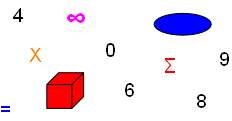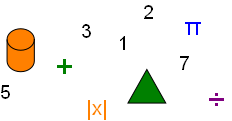



Synthetic Division of Polynomials
(Synthetic Substitution)


When compared to Polynomial Long Division, Synthetic Division reduces the number of steps to divide a polynomial by a binomial divisor of form x – r; where r is a real or complex number.
Let P(x) = x4 + 6x3 + 5x2 − 4x + 2, the dividend.
Let F(x) = x + 2, the binomial divisor.
P(x) is a polynomial of degree four and we know that if x4 is divided by x the result will be x3 [ i.e., x4 / x = x3 ], one degree less. The same idea continues as we divide each term of P(x) having an x. This tells us that dividing a polynomial of highest degree xn by x results in a quotient with xn − 1 highest degree and that the other terms having an x are also reduced by one magnitude. By understanding this fundamental concept we can eliminate x from the binomial divisor during the polynomial divide process and only focus on r of x − r. This is exactly what we do to synthetically divide a polynomial.
To divide P(x) by F(x) synthetically first note that the binomial divisor F(x) is x + 2; the binomial divisor needs to be of form x − r, so the +2 of x + 2 will be changed to −2 for the division process, its negative (if the divisor was x − 2 instead of x + 2 the sign of −2 would be changed to +2 for the synthetic division). The setup follows.
First remove the x from all terms of P(x) = x4 + 6x3 + 5x2 − 4x + 2 and write as:
1 + 6 + 5 − 4 + 2 (−2
____________
P(x) with each x removed and the divisor −2
Blank line (for tabulation)
Blank line (for tabulation)
The coefficient of the first term of the quotient will be the same as that of the dividend so just write this coefficient on the third line:
1 + 6 + 5 − 4 + 2 (−2
_____________
1
Next, multiply the divisor −2 by the first coefficient on line 3 and write that result on line two beneath the second coefficient of the first line.
1 + 6 + 5 − 4 + 2 (−2
− 2
_____________
1 + 4
The −2 divisor is multiplied by the first coefficient on line three.
The result +4 is the addition of line one +6 and second line −2.
Repeat this process for each coefficient…
1 + 6 + 5 − 4 + 2 (−2
− 2 − 8
_____________
1 + 4 − 3
The −2 divisor is multiplied by the second coefficient on line three.
Result −3 is the addition of +5 (line one) and −8 (second line).
1 + 6 + 5 − 4 + 2 (−2
− 2 − 8 + 6
_____________
1 + 4 − 3 + 2
The −2 divisor is multiplied by the third coefficient on line three.
Result +2 is the addition of −4 (line one) and +6 (second line).
1 + 6 + 5 − 4 + 2 (−2
− 2 − 8 + 6 − 4
_____________
1 + 4 − 3 + 2 − 2
The −2 divisor is multiplied by the fourth coefficient on line three.
Result −2 is the addition of +2 (line one) and −4 (second line).
The coefficient on line three, farthest right, is the remainder, −2. All other coefficients on line three to the left of the remainder are coefficients of the quotient (1 + 4 − 3 + 2). The result of the synthetic division can now be written as:
x3 + 4x2 − 3x + 2 with remainder −2.
Note that if a term is missing from a polynomial, that term would be a +0 coefficient during synthetic dividing. If P(x) = x4 + 6x3 − 4x + 2 we would setup the synthetic division as:
1 + 6 + 0 − 4 + 2 (−2
_____________
The x2 term is missing from the divisor P(x) and has +0 for synthetic division.
One more example:
P(x) = x4 − 4x3 +3x + 10
F(x) = x − 3
1 − 4 + 0 + 3 + 10 (+3
+ 3 − 3 − 9 − 18
_____________
1 − 1 − 3 − 6 − 8
The quotient is x3 − x2 − 3x − 6 with a remainder of −8.
Copyright © DigitMath.com
All Rights Reserved.